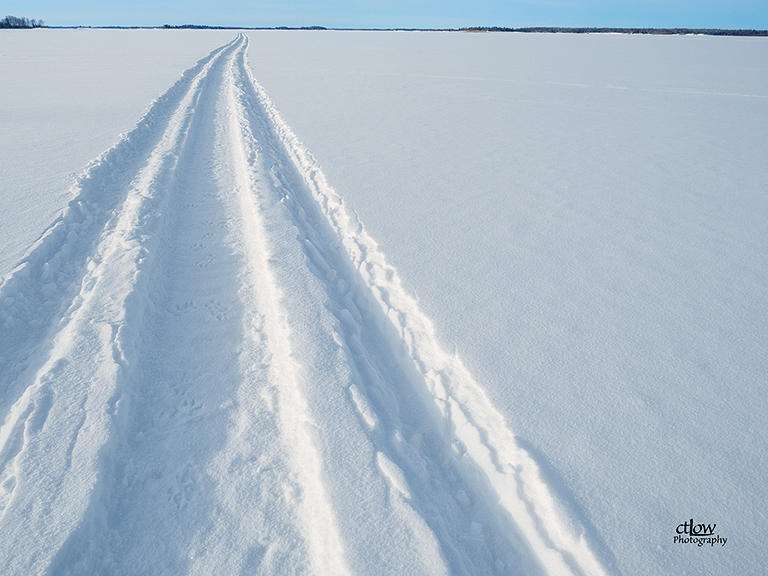Charles T. Low Photography

Blog
Northern Manitoba
A Good Place to Stark
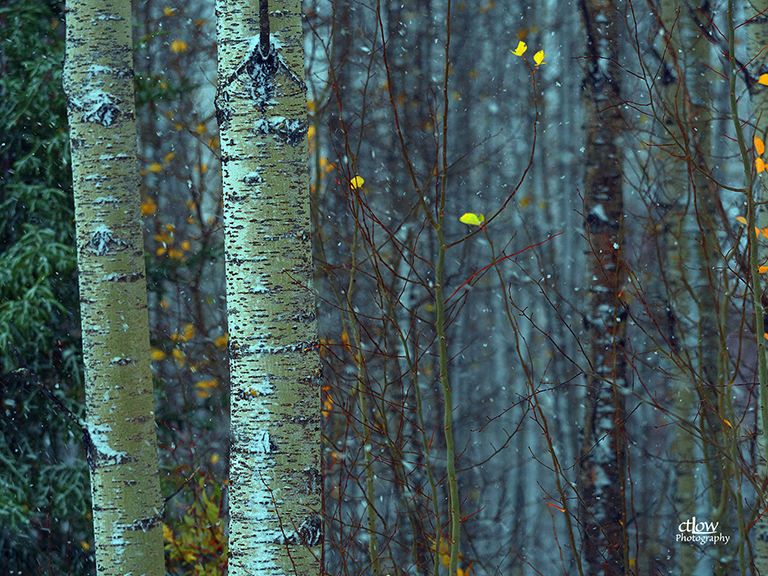
Couple of things:
- My exhibition continues at the Brockville Public Library, and for those of you for whom, like me, time flies around, may I just say that it is already half over.
- I/we have personal reasons for returning, from time to time, to Northern Manitoba.
We are not tourists there, and at one point I asked the always-fully-booked cottage owner what other people came for — was it more for hunting, or was it fishing? "Oh," he said, "they're pretty well all utility-workers."
Now ... there are camps up there, commercial enterprises for these sorts of wilderness activities, but that has not been, so far, our jam.
But ... I am a fine-art photographer, as much an identity as an activity, and I always travel with cameras and equipment.
And there is an undeniable and ... stark ... beauty to the boreal landscape.
I hesitate however to admit that I had to work at it, at first, more than I do in my usual more southerly
haunts. (I put southerly
in quotes because it is a relative term.) The landscape is ... may I call it ... spare
, compared with Eastern Ontario.
I hesitate further to admit to a bias. I don't like scruff
, brown tangles of vegetation which end up so easily in photographs, for no other reason than that they were there. It's the artist's job to work around that, and if that is not possible, with a certain scene, then perhaps I should be making a photograph of something else.
(Intentional scruff, used with artistry, is another matter, but that's the exception, in my limited experience.)
And the boreal forest of Northern Manitoba just cannot grow as vibrantly, when the winters get down to -40°C and below, as they do elsewhere. This is absolutely other than scruff
, but I had to get past the tangle of my own preconceptions to see that. Also, having visited the tropics, they have a lushness which temperate climates, like where I live, cannot hope to replicate, but photographers manage very well everywhere; everything is relative.
Speaking of relatives, one of them exclaimed, as we were driving north, from prairie into Canadian Shield, "This is so amazingly beautiful!" I thought to myself, "No it isn't. Am I missing something?" It turned out that I was. Tiny comments like that can stick with me, and change my whole mindset.
So I had to learn to see more deeply (which is good for me), beyond the smaller trees, and the fewer species of plants, and once I did that, then a whole new visual world opened up. It is getting easier. Here is a small sample from recent years.

The photograph above, of a frozen swamp with stands of trees (Black Spruce, I believe), I made about a week ago while out walking dogs. I did not have my full photo-kit with me, and did not have any time to compose it and make several variations. It was just there, in front of me, and the way the elements came together pleased me, so I snapped with the closest camera to hand (you can guess).
It is simply a scene which could not be Eastern Ontario. (And the further north you go ... well, everyone I know says that there is just something deeply compelling about the light.)
Below is an autumnal scene of Tamarack, aka Larch. I wondered at first if they were all diseased, some blight perhaps, or was this their normal colour, but it turns out that they are one of the minority of conifers which are deciduous, and these were preparing to shed their needles for the winter.
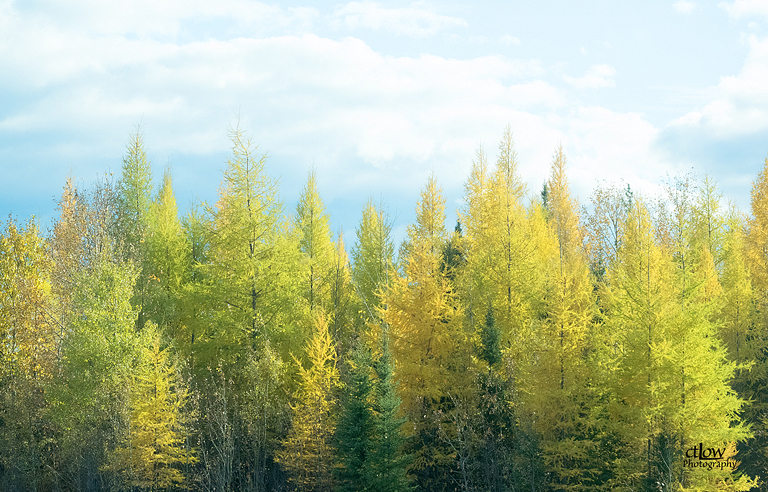
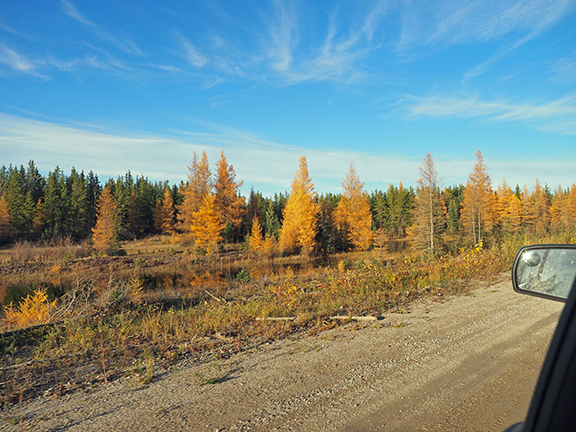
(-this one still feels scruffy
to me)
I'm exposing a vulnerability with the photographs immediately above and below, so please be gentle with me. I made the one above, years ago, to illustrate that the area was not photographable.
How wrong I was! But you may be able to see that one can't just point the lens anywhere and hope to get an art-image. That is of course always the case, anywhere, anytime, but this just felt particularly difficult, until my mind adapted.
The one below falls into a different category. We believe that it is also Tamarack, with the needles off, and it is very different from what I usually produce. (Check out Dawn, for contrast.) Talk about stark! I personally find this work more interesting than beautiful, but some observers have simply raved about it. And I don't know about you, but my eye goes to the (deliberately) out-of-focus tree in the background, which, compositionally, should not work, but does (for me).
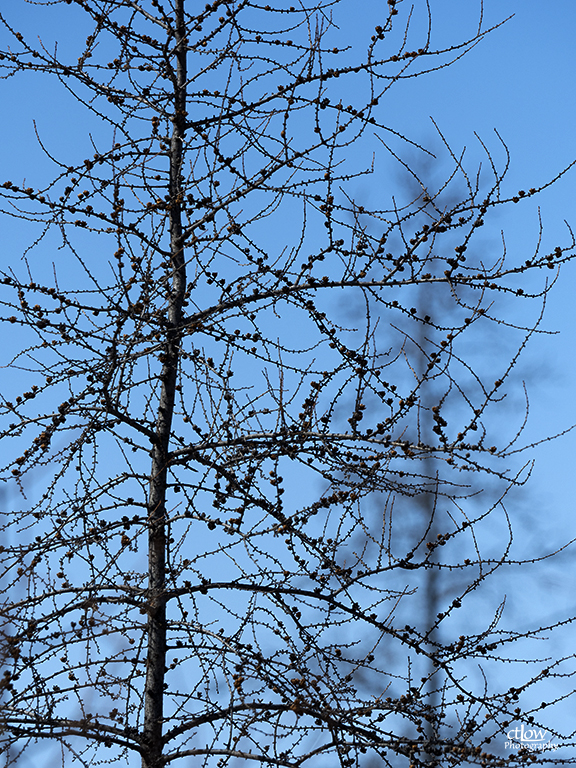
And man, could I go on. Just let me say how many images I am omitting. As with photographic composition, it is usually better not to try to get everything in.
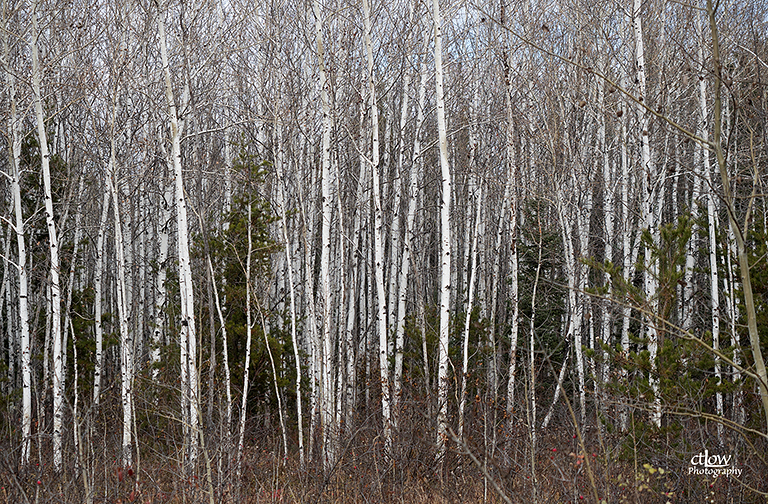
I often say that landscape photographers should fall down on their knees every day and give thanks for birch trees. They do make the work, whether in a stark or a lush landscape, much easier. And birches are abundant in the north.
The one above was mid-day (on a Thanksgiving weekend picnic!), and one below at sunset from the back deck of a house.
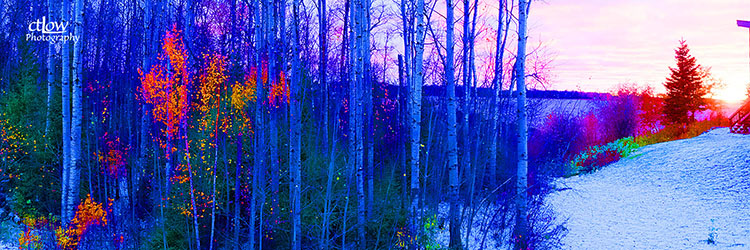
Is It Stark?
I may have gained a little more insight just by writing this blog. I'm no longer as sure of myself (which can be progress) in using the work "stark" at all. It is simply breath-takingly, achingly beautiful, way up there in Northern Manitoba.
It has occurred to me to lead a photography-seminar excursion there. It's not easy to get to, but so very worth the effort. You know where to find me.
Subscribe
I would love it if you were to subscribe to this blog, and to refer friends.
You may wish to look through my larger portfolio. Almost everything is for sale. I favour large wall art, and also deal in books and other small items: prints, notecards, and postcards.
Thank you all so much for reading! Kindly comment.
Charles T. Low
Photographer
Blog #81
2022-05-04
